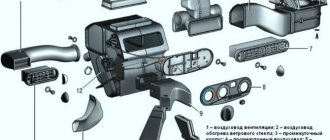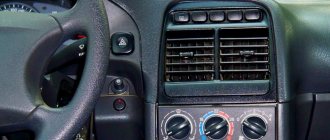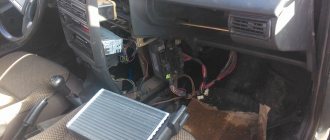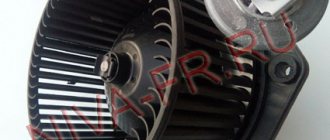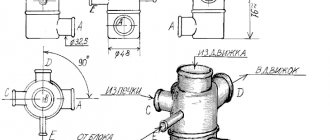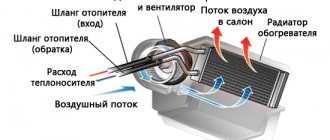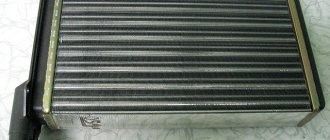When purchasing a new car, most owners begin to study the technical documentation that accompanies any device. Indeed, this is the right action. This is how the owner will be able to find out for himself the design features of the devices with which the new Chevrolet Niva is equipped. Having such technical information, it is much easier to “diagnose” problems, as well as faster and easier to find ways to solve them. Since many Chevy Niva owners have had to deal with unpleasant situations associated with poor heater performance, it will not be superfluous to understand what the interior heater on your Chevrolet Niva consists of. On the Internet it is easy to find heater diagrams, as well as a listing of all the components of this device. To save your time, we invite you to take a short technical tour with us. We will not only accompany you, but also focus on important details. Such training will not be superfluous, since you will absolutely understand the connection diagram of the stove, and it will also become clear how to improve or, if necessary, restore the operation of the heating system.
Heater diagram
If the temperature with a fully warmed-up engine is within degrees, we look for the reasons for the lack of air in the legs in the heater design.
A feature of the stove on a Chevrolet Niva is the absence of a heater radiator tap, that is, antifreeze circulates in a full circle in winter and summer and passes through the heater radiator. Taking this fact into account, the factory somewhat complicated the design of the air ducts and air dampers - there are two of them in the Chevrolet Niva. One works for frontal airflow, the second is responsible for supplying air to the feet of the front and rear passengers and the driver.
It is with this damper that problems arise that we will try to solve. We take out the central air duct and the air duct that conducts air to the driver’s feet.
Unscrew 2 screws on the radiator.
And we begin to assemble in reverse order. If during assembly you have a couple of extra screws left, then you have assembled everything correctly! If you have any questions or maybe I forgot to add something, please contact me, I’ll be happy to help.
Niva Chevrolet Shaitan Cyclone in the legs, revision!
The selection of the stove operating mode, temperature and air flow direction is made using the stove control unit located on the center console. Heating system with air conditioning The principle of operation of a car heater with air conditioning is similar to that described above. However, its design is significantly different. Instead of an intermediate heater housing, an air conditioner evaporator is installed, hidden by a plastic casing.
When the air conditioner is turned on, air is supplied to the cabin through the evaporator using a damper. The design of a car heater with air conditioning is somewhat different: To carry out high-quality repairs, you first need to understand the reasons and identify the faulty element of the system.
The stove does not heat the footwell. There may be several reasons why the stove does not direct air to the feet. First you need to find out whether this mode is turned on correctly.
Due to the design features of the damper system, the direction of air to the legs is carried out as follows: Set the fourth rotation speed of the stove fan. Set the heater mode switch to the upper vertical position.
Switch the mode controller one position to the left. After this, air should begin to flow into the legs. If this does not happen, the procedure should be repeated several more times.
If the mode still does not turn on, you should check the following components: Coolant leakage If antifreeze leaks from the cooling system without visible streaks on the radiator and pipes, you need to pay attention to the condition of the heating system
The main signs of a coolant leak through the heater are: Typically, the leak occurs through the heater radiator. To verify this, you need to remove the lower part of the center console.
DIY heater replacement
If traces of moisture are detected in the area of the stove body, it is recommended to replace the radiator. If a coolant leak is detected through the heater radiator, it should be replaced. Before replacing the heater radiator, you should check the tightness of the heater pipes and their connections.
The stove does not warm up the air well. Often the stove does not warm up the interior effectively enough. Instead of hot air, slightly warm or even cool air comes from the deflectors.
This usually happens for the following reasons: Before the decisive step of removing and replacing the heater, you should pay attention to the heater core. It may well be that the reason for the non-working state lies precisely in this
In a Chevrolet Niva car, the stove can be installed and removed without any problems, the main thing is to follow the procedure. Radiator The radiator of the Niva-Chevrolet stove is a sensitive topic and deserves separate consideration.
The standard heating system in this car does not always work well and produces little heat. The standard radiator begins to leak over time, and you have to replace it.
But don’t rush, maybe it makes sense to clean it or solder it? But if there is no option other than replacement, then that’s what you should do.
Before replacing the radiator, you need to understand the existing types of such devices. Types of radiators Radiators are made from two types of materials: Each has its own pros and cons. An aluminum radiator heats up quickly, is inexpensive and has good rigidity with low weight.
Refinement of the heating system of the Chevrolet Niva
When the intensity of supply of air heated by the heater into the cabin decreases, it becomes necessary to modify the heating system. This is due to errors in the assembly of the system. The main problem is the lack of tightness in the air ducts and dampers. This leads to incorrect distribution of warm air throughout the cabin. The modification is carried out as follows.
- The steering column casing and driver's side console are removed.
- On the heater side, a plate is removed that sets the direction of air supply.
The die located on the heater side needs improvement - The slot at the top of the die is made straight while maintaining the starting and ending points. To give the desired trajectory of movement of the damper, you can glue a plastic card to the die.
To give the desired trajectory of movement of the damper, you can glue a plastic card to the die - The lower flap, which is responsible for supplying air to the legs, is rigidly attached. To do this, a homemade bracket is cut out.
The last stage of modification of the stove is the rigid fixation of the lower damper
As a result, warm air will be distributed throughout the cabin strictly in accordance with the position of the flow direction regulator.
Thus, even an inexperienced car enthusiast can ensure a comfortable microclimate in the interior of a Chevrolet Niva car. To do this, you just need to strictly follow the instructions and recommendations of professionals.
VAZ 2121 (Niva 4x4): replacing the heater radiator with your own hands
Replacing the pump yourself on a Niva Chevrolet: quickly, efficiently and with your own hands
Heater diagram
The most common reason for its failure is: Warm air does not enter the lower part of the cabin Before starting repairs of the stove, you should check the temperature of the coolant. Perhaps the problem is not in the interior heater, but in the cooling system.
With the help of damper position regulators, warm air is directed to different parts of the cabin. First, the dampers should be adjusted. To supply hot air to your feet, follow these steps: The engine warms up until the warm air can be felt with your hand. Consequently, it is almost impossible to open the tap without breaking it.
stove Niva Chevrolet
https://youtube.com/watch?v=UNMCm8ypDbI
To get to it, you need to dismantle the dashboard in the cabin on the passenger side. The stove tap is mounted in a special niche in the engine compartment. If the tap has been replaced, then it is better to install new pipes along with it, because during operation they have probably lost their elasticity.
Collective farm tuning of the Niva Chevrolet stove: In some cases, the correct switching method does not work and then you have to modify the heater in order to achieve its full functionality. The main problem with dampers and ducts is leakage.
We will improve the cracks and eliminate leaks in the stove. Remove the heater control unit by disconnecting all wires and cables from it. If there is a radio, remove that too. Disconnect the transmission tunnel lining.
You don’t have to remove it completely, but only lift it by unscrewing two screws on the driver’s and passenger’s sides. Remove the steering wheel, steering column trim and unscrew the screws securing the front panel. When removing the dashboard, mark all the wires to make it easier to reattach them in their places in the future.
Without removing the entire front panel, when dismantling the heater unit, some elements of the air conditioner and the stove itself can be damaged. Remove the front panel frame attached to the body with screws. The heater housing cannot be removed without dismantling the front panel frame. Behind the frame you will find the heater unit casing, connected to the intermediate housing of the heater or to the evaporator section on a car with air conditioning.
Chevrolet Niva 2012, 80 l. With. — self-repair
Installation of a new unit is carried out in reverse order. The most common purpose of such tuning is to improve the air supply to the driver's and front passenger's footwells. To do this, install additional air ducts and adjust the shape of the damper drive strip
For such modification you will need: You must work with the plastic of the heater housing very carefully, as it is quite fragile
The steps are performed in the following order: Select tubes suitable for the role of additional air ducts. You can use plumbing pipes as additional air ducts. Remove the side trims on the center console on both sides.
Air flows in the cabin are distributed by air ducts, which are located under the instrument panel and under the floor tunnel lining, and under the floor upholstery to supply air to the feet of the rear passengers.
To control the distribution of air flows, use the distribution regulator handle on the center console of the instrument panel, as well as the regulators and guides of the central and side deflectors on the instrument panel.
To heat the interior, move the temperature control knob to the hot red zone. In this case, the outside air is directed using a damper through the heater radiator, which is integrated with the engine cooling system.
Remove the screws of the tie rod brackets. Disconnect the rods from the heater damper levers. Unscrew the screw of the bracket securing the recirculation flap drive rod and remove the lever bracket and disconnect the wiring harness block from the heater electric fan switch.
Heater diagram First of all, we want to orient you that the Niva already has a liquid-type heater installed, which allows you not only to supply warm air into the car interior, but also to cool the running engine, preventing it from overheating. It's no secret that overheating the engine entails extremely undesirable consequences.
An electromagnetic clutch is built into the compressor pulley, which engages and disengages the compressor shaft from the pulley according to signals from the engine control system controller. Refrigerant vapor from the compressor under high pressure enters the condenser located in front of the radiator of the engine cooling system. Passing through the honeycombs of the condenser, the refrigerant is cooled by the counter flow of air and with the help of fans of the cooling system.
Heating switches
Left Rotary Switch:
Temperature, fig. 25.
Middle Rotary Switch:
Air distribution, fig. 26.
Right rotary switch:
Airflow (fan), fig. 27.
Four speeds:
- 0 – disabled
- 4 – maximum air flow.
The blower fan allows you to increase the volume of incoming air, which provides additional comfort when driving and accelerates the removal of icing and warming up the interior. Therefore, it is necessary to turn on the airflow while driving.
Figure 28 shows the damper control lever:
- in the extreme left position, outside air enters the cabin;
- in the middle position of the lever, outside air and air are mixed,
- circulating inside the cabin;
- in the extreme right position, the recirculation mode is activated.
When the recirculation mode is turned on, the supply of outside air is cut off. This mode can be useful, for example, when driving through a tunnel or when driving in a traffic jam to prevent air saturated with exhaust gases from entering the cabin. Prolonged circulation of air inside the car can lead to fogging of the windows.
Heater air intake, fig. 29, is located under the soundproofing padding in the engine compartment under the shafts of the windshield wiper arms. The air intake openings must be clear for air to flow in, and if necessary, remove leaves, dirt or snow.
The air filter is installed in the heater air intake box, which cleans the air entering the cabin from dust, soot, pollen, etc.
Replacing the stove fan
Replacing a heater motor is quite simple.
Required Tools
To work you will need:
- set of hex keys;
- Phillips screwdriver;
- new electric heater motor.
Removing the stove fan
The stove fan is removed as follows.
- The negative terminal of the battery is disconnected.
- On the right (in the direction of travel) under the windshield there is a cabin filter protected by a snap-on lid. After removing the cover and removing the filter, access to the heater fan is available. To access the heater fan, the cabin filter is removed
- The impeller is removed. To do this, use a Phillips screwdriver to unscrew the bolt holding the mounting bracket. The impeller moves to the side and is removed. To remove the impeller, you need to unscrew the bolt and remove the mounting bracket
- In the cabin, in front of the passenger seat, the fastening of the glove compartment panel is unscrewed. To access the electric motor, the glove box panel is removed
- The connector with the power wires is disconnected. To remove the electric motor, you must disconnect the connector with the power wires
- Use a short 10mm hex to unscrew the mounting bolts and remove the electric motor. The heater motor is secured with three bolts
- After removing the engine, the impeller is carefully removed through the cabin filter niche. The impeller can be pulled out freely from the cabin filter side
Installing a stove fan
The faulty electric motor is repaired or replaced with a new one. A damaged impeller should also be replaced. A thin wire is threaded through the holes in its body and the cavity of the cabin filter is secured. The impeller must be installed in such a way that the groove located inside it fits into the pin of the electric motor shaft.
Before installing a new engine, the axle is lubricated with a special lubricant.
Assembly is performed in reverse order. If the impeller does not fit into place, it should be moved several times in different directions until it is completely seated on the motor shaft. Then, under the hood, the wire is cut with wire cutters, the mounting bracket is installed and the bolt is tightened. New heater fan installed.
Thus, diagnosing faults, repairing and replacing the heater fan on a Chevrolet Niva is not very difficult. This will require a minimum set of standard tools. Keep an eye on the stove, and the inside of your car will always be warm.
Dismantling
Now it’s time to talk about how to remove the stove on a Niva. It is dismantled due to a breakdown or when it interferes with the repair of other equipment. To remove the stove, prepare a set of tools.
Before the heater is removed from the car, the Niva-Chevrolet is initially de-energized. In other words, you need to disconnect and remove the battery. Then remove the instrument panel. On the stove control panel there are handles that are responsible for heating and air circulation. Let's take them off.
After carrying out the above work, remove the decorative control panel of the stove. Using a Phillips screwdriver, unscrew the screw securing the bracket. Next, remove the light bulbs that serve to illuminate the levers. Unscrew the screw securing the bracket and disconnect the damper drive rods. Next, unhook all the wires and remove the remaining rods. The next step is to remove the fan and heater switch after unscrewing the element that secures it to the instrument panel.
At this stage, the removal of the stove is completed. After the necessary maintenance, we reassemble in the reverse order.
My account
After removing the glove compartment, access to the heater valve opens. A rod is attached to the crane lever using a clamping bracket. Use an open-end wrench size 7 to loosen the nut located on the bracket.
The traction cable is removed from the crane lever. Using an open-end wrench, the fastening of the rod is loosened. Using a 10mm socket, unscrew the two bolts securing the faucet to the wall of the engine compartment. The mounting bolts of the heating tap are unscrewed with a 10 mm socket wrench. The heater tap is removed from its niche and replaced with a new one.
The heating tap is removed from its seat. The tap is assembled and installed in the reverse order. Initially, you should disconnect the hose from the pipe. This action is quite difficult, since the hose sits tightly on the pipe. If you move incorrectly, your hand may slip and you may be injured.
For this reason, we recommend that you wear gloves to avoid such unfortunate consequences. Now, using a screwdriver, unscrew the screws that secure the seal, pressing it against the partition.
To dismantle the stove faucet, it is necessary to drain the antifreeze. Open the faucet as far as possible. We substitute the hose and insert one end into the basin. To drain the antifreeze, you need to unscrew the plug on the cylinder block. Lightly hold the hose with your hand and gradually open the cap located on the expansion tank.
We do this work carefully, as the stream of antifreeze will gradually increase
In order to remove the stove valve, it is necessary to completely drain the antifreeze. Loosen the clamp on the carburetor heating pipe and remove this part from the fitting. After all the coolant has flowed out, screw the plug into the block and tighten it well. Antifreeze leakage from the stove In used cars, coolant often begins to leak from the stove. The reason for this is usually wear and tear on the pipes or a malfunction of the heater tap.
Since antifreeze circulates under pressure, all connections must be tight. However, during prolonged use, hoses and gaskets lose their elasticity and burst. After inspecting the heating system and identifying the leak, the worn part is replaced with a new one. When making repairs, you should not use clamps made in China due to their poor quality.
Due to loss of elasticity, the stove pipes crack over time and leak antifreeze. The coolant can also leak from the heater radiator itself. In this case, it will have to be replaced with a new one.
Replacing a Chevrolet Niva Chevrolet heater core
https://youtube.com/watch?v=PgDz4rJ2GJ0
The stove does not heat well. To diagnose the malfunction, turn on the ignition, start the stove and try to change the intensity of the air supply. If at the first three speeds the air is not supplied or is supplied cold, the cause of this is a faulty resistor that needs to be replaced.
The reason for the inability to switch speeds is the failure of the resistor. If the resistor is OK, the diagnosis continues. If it is low, add antifreeze to normal and check it after a few days.
If the level has noticeably decreased, you should pay attention to the hoses and pipes, wear of which is usually the cause of coolant leakage. One of the reasons for poor heating of the interior by the heater may be a low level of coolant in the system. If the control unit malfunctions, it will have to be removed
Faucet replacement process
Repairing the unit at home is only possible if you have the appropriate tools - it’s easier to contact a car service center.
Another reason for the stove stopping may be a dust-clogged cabin filter.
In this case, the load on the electric motor increases, which, in turn, leads to failure of the heater fuse. In this case, it should be washed. This is true when purchasing and operating used cars. However, it can sometimes fail. Replacing the heater cable Sometimes it is not possible to change the position of the heater damper.
The reason for this is a broken cable. To replace it, you will need a standard set of tools and a headlamp. Replacing the cable is carried out as follows. The driver's seat moves back. The handles are removed from the damper control panel and the screws are unscrewed.
The panel is dismantled on the left side at the location of the driver's feet. To access the cable, you will need to remove the heater control mechanism. The latches securing the cables are removed. The recirculation damper mechanism is dismantled and the cable is removed.
Each end must be twisted into a ring and securely fixed. Using a cable, the position of the air supply flap is changed. Assembly is carried out in the reverse order.
Causes of the problem and solutions
Any experienced motorist will confidently confirm that for the excellent performance of any vehicle, it is very important that the owner learns to “feel” the car and intervene in time if it begins to experience problems. Unfortunately, some beginners complain that it gets incredibly hot inside the Niva, but for some reason their feet freeze. This is the case for those who either haven’t read the technical manual or ignore the manufacturer’s recommendations.
Of course, the cause of poor heating is not always the wrong actions of the driver himself. Sometimes poor performance of the stove is caused by breakdowns, which can be easily repaired by service station specialists. However, we recommend that you abandon such a tempting and at the same time financially burdensome venture. It’s better to use our tips and return your car’s heater to excellent performance yourself.
Algorithm of actions
Initially, we suggest you figure out how to properly turn on the stove and regulate the direction of the flow of warm air. In most cases, due to simple ignorance, the driver adjusts the position of the damper in such a way that the entire flow of warm air is directed to the windshield, and also mercilessly blows directly into the face of the driver and passenger. At the same moment, the feet of those in the cabin simply freeze, since no warm air gets there at all.
The problem is that the Chevrolet Niva has its own algorithm for supplying warm air, which you want to direct to the lower part of the cabin.
After starting the car, warm up the engine thoroughly. The guideline for subsequent actions should be a flow of warm air, which will clearly be felt by your hand. Only after this we recommend that you set the fan speed switch to the fourth position. Now turn the air flow direction control knob to 12 o'clock, and then immediately return it to the 11 o'clock position. If you did everything correctly, you should hear a characteristic click. It will act as a kind of signal that the air damper has taken a position in which the flow of heat will be directed to the legs. All you have to do is adjust the heating intensity and enjoy comfortable conditions in the cabin. Do not despair if such “magic” did not work for you the first time. We recommend that you try again and you will be convinced of the effectiveness of such actions.
However, it is important to note that such “magic” will only work in cases where the components have not been subjected to mechanical damage. If at least some component fails, you will have to carry out repair measures.
On a Chevrolet Niva, repairs to the heater damper are often carried out because no action can be taken to change the position of the damper. Most often, such “immobilization” of the damper is caused by a broken cable. In this case, you will have to work hard, it certainly won’t be easy for you, but you can still carry out such repairs yourself, so don’t rush to the auto repairmen.
Initially, prepare tools and some items that will make the task easier. Since you will have to bend down and manipulate under the bottom of the dashboard, we recommend that you purchase a headlamp or install the flashlight so that its light output is directed to the place you need. It would also be quite appropriate to move the front seat back slightly to expand the space for yourself.
After completing such preparatory work, proceed to direct action. First, remove the handles from the damper control panel, then unscrew the screws. Now unscrew and remove the panel located on the left side, where the driver’s feet are always located. You will find latches that act as fastenings for the cables; they need to be unfastened. All that remains is to remove the recirculation damper mechanism and pull out the damaged cable. Instead, install any other suitable cable, having previously measured its length so that it matches the production analogue. Twist each end of the cable into rings and securely secure. Reassemble all the components you previously removed and check the operation of the dampers. The result of the work will definitely please you, since the dampers will be on you, and accordingly, the interior of your car will warm up quickly, creating a comfortable temperature regime.
What is a stove tap, its functional features and location
The stove tap is a metal part that resembles a regular water tap. Antifreeze (coolant or coolant) constantly flows through it.
In the Chevrolet Niva, the coolant can flow through 2 cooling circles: winter and summer. The heating tap gives the driver the opportunity to switch to one of them. For example, with the onset of summer, when the tap is fully open, it is almost unbearable to be inside the car due to the heat, so it is closed for this period of time, and with the onset of cold weather, the tap is opened again. Due to active use, the part eventually becomes unusable and leaks coolant.
It is very easy to determine whether a part is faulty - lift the cover in the Chevrolet Niva interior. If there are obvious signs of leakage, the unit must be replaced.
In the diagram you can see where the heater tap is located and the circulation of antifreeze in two circles
It is best to replace the metal faucet of the stove with a ceramic one, which will increase its service life several times.
Blowing nozzles
Central air nozzles, fig. thirty.
The air supply is regulated by the levers 1 of the guide vanes of the central nozzles by changing the position of the dampers up or down, and the air supply intensity regulator 2 opens or closes the central blowing nozzles completely. Depending on the position of the temperature switch, comfortable airflow of the upper space of the cabin with unheated or warm air is provided.
To increase air flow, turn on the blower fan and set the middle rotary switch to position.
Side air nozzles, fig. 31.
Normal or warm air enters the cabin through the nozzles. The air supply is regulated by the levers 1 of the guide vanes of the side nozzles by changing the position of the flaps up or down, and the air supply intensity regulator 2 opens or closes the side blowing nozzles completely.
The direction of air flow can be adjusted so that a warm air cushion can be created over the door area in cold weather.
To increase air flow, turn on the blower fan and set the middle rotary switch to position.
Nozzles for blowing windows and front doors, fig. 32.
Set the damper control lever to the far left position and the middle rotary switch to the position: cold or heated air will be directed towards the windshield and side windows (mainly in areas where exterior mirrors are installed).
Upper air nozzles, fig. 33.
Set the damper control lever to the far left position and the middle rotary switch to:
- cold or heated air will be directed towards the windshield;
- middle rotary switch in position;
- When the damper is open, the additional air supply regulator provides additional air supply.
Lower air nozzles, fig. 34.
Unheated or warm air is supplied to the lower part of the cabin (to the driver’s and passengers’ foot areas). To increase the air flow, switch the blower fan to a higher level and set the air distributor to the middle rotary switch position.
Interior ventilation, fig. 35.
In the extreme left position of the damper control lever, outside air enters the vehicle interior:
- through the upper air nozzles and the front door window nozzles, if you move the middle rotary switch to position;
- through the side and central nozzles,
- if the middle rotary switch is turned to position.
Air supply intensity regulators through the side and central nozzles regulate the air supply by changing the position of the dampers until they are completely closed. In this position, when the damper is open, the additional air supply regulator provides additional air supply through the upper nozzles.
- through the lower nozzles into the driver's and passenger footwells when the middle rotary switch is in position. When turning the levers of the guide vanes of the side and central nozzles, the direction of the air flow changes.
To increase the air supply to the vehicle interior, set the right rotary switch to one of four heater fan modes.
How to remove and install the stove tap
To replace a part, you must initially prepare the appropriate consumables, as well as tools:
- open-end and socket wrenches;
- pliers;
- flat screwdriver;
- a five-liter tank into which you will need to drain the liquid from the radiator;
- new faucet.
After preparing the necessary tools, you can begin replacing the tap, and the sequence of actions should be as follows:
- We install any container with a volume of about five liters under the radiator and unscrew the cap on it. Wait approximately 10 minutes until all the coolant has drained.
- Next, open the hood of the car and loosen the pipe clamp on the tap pipe.
- We take pliers, carefully bend them and pull out the short cotter pin.
Remove the heating tap clamp using pliers
Unscrew the screws securing the seal using a 7" wrench
Remove the sealing plate from the faucet
In order to get to the stove tap, unscrew the nuts and remove the glove box
Using an open-end wrench, loosen the nut fastenings to remove the traction cable
Unscrew the heating tap mounting bolts
A pipe is installed on the part, as well as rod fastenings; in this case, new gaskets must be used, which are pre-coated with sealant.
Sealing plates are coated with sealant to reduce the risk of coolant leakage
The tap is put in place as follows:
- We tighten the two nuts on the pipe with the rod using a “10” wrench.
- We put the part in place and tighten the fastening bolts located on the tap.
- We install the rod and tighten the clamping bolt using the key to “7”.
- We tighten the self-tapping screws that hold the sealing gasket with an “8” wrench.
- We insert the pipes into the fittings and tighten the clamps.
The new heating tap is installed in the reverse order
Check whether the second pipe is tightly connected to the radiator; if not, then replace the gaskets there too. In addition, we strongly recommend installing new hose clamps.
When filling the system with liquid, fill it slowly to avoid air pockets. Antifreeze is poured in until it begins to flow out of the pipe. Moreover, the heating tap must be open.
Antifreeze must be poured into the heating system carefully, avoiding the formation of air pockets.
Video: how to install a heater tap on a Chevrolet Niva
Replacing a broken tap with a new one on a Chevrolet Niva is easy. To do this, you need to acquire the usual set of tools that are found in every car, and buy a new faucet. After which even an inexperienced driver will be able to install it on the car.
Types of radiators
Radiators are made from two types of materials: copper and aluminum. Each has its own pros and cons. An aluminum radiator heats up quickly, is inexpensive and has good rigidity with low weight. However, such a device cannot be repaired, since it is very problematic to solder it. Aluminum also does not retain heat well, so it cools quickly.
Copper radiators are more expensive, but have their own positive characteristics:
- Unlike aluminum ones, they last longer because copper does not corrode.
- They maintain the set temperature for a long time, despite the fact that they heat up slowly. In the Niva SUV, the stove requires heating more space than in conventional sedans. This is why you should choose a high-quality radiator.
The downside of a copper radiator is one thing: acquiring parts of acceptable quality is not very easy. A copper device is more expensive than an aluminum one. Its price is in the range of 2000–2500 rubles.
Symptoms of a malfunctioning stove fan
The main signs of a stove fan failure are as follows:
- the electric motor does not work;
- the rotation speed of the electric motor decreases;
- The fan starts to creak.
Depending on the symptoms that appear, the procedure for eliminating the problem is determined.
The electric motor does not work
If the electric motor stops working, the noise in the cabin disappears when the heater is turned on.
Often the reason for this is the failure of fuse F18 with a rating of 25A in the corresponding block, through which voltage is supplied to the stove motor.
Another reason may be damage to the fan motor winding - if the wire insulation is damaged, an interturn short circuit may occur. In this case, the electric motor must be replaced.
When there is an interturn short circuit, the electric motor stops working.
The rotation speed of the electric motor decreases
When the rotation speed of the motor shaft decreases, it is somewhat more difficult to determine the source of the problem. The noise level becomes noticeably lower as the motor power decreases. This may be due to severe wear on the armature or brushes. In addition, the fan begins to consume much more current, and this can lead to the failure of fuse F18.
If the armature is heavily worn, the electric motor will rotate much more slowly.
The fan starts to creak
The fan begins to creak when the motor bearings wear out. The more wear, the stronger the squeak. If you do not take any action, the heater fuse will burn out and the motor itself will jam. In this case, the electric motor should be replaced with a new one.
Replacing the heater fan fuse
Almost any malfunction of the stove motor leads to the replacement of fuse F18. On a Chevrolet Niva car, the fuse box is located in the passenger compartment under the instrument panel and is closed with a cover secured with two self-tapping screws. When replacing F18, it is recommended to check and, if necessary, replace other fuses.
The heater fuse is located in the fuse box under the instrument panel
If fuse F18 has to be changed quite often, then the problem should be looked for elsewhere. There may be a short circuit somewhere in the motor power supply circuit. Sometimes the fuse blows as a result of severe contamination of the cabin filter. In this case, the electric motor does not have enough power for normal air ventilation, and the fuse fails.
Often the cause of the heater motor stopping is a blown fuse.
The suspicious fuse is removed from its seat in the block using special tweezers. If it burns out, a new one is installed in its place. When checking, it is better to use a multimeter, since it can be difficult to visually determine the integrity of the fuse.
conclusions
Thus, you can repair your car’s heating system yourself if warm air does not flow into the cabin.
I have this problem. Almost a year ago I bought a Shevik Niva... And everything seemed to be fine, the car was not old, 2007, it was in excellent condition, it had no problems. But for the last 3 months the stove has practically stopped heating. It blows weakly. The engine heats up to about 90 degrees, but the heater gives no more than 60. I tried to blow it out, I decided that it was clogged, but no. Everything is well ventilated. What to do in such a situation? It's cold outside. We have Siberia after all.
The stove is the central element of the interior heating system of any car. Any malfunction, especially in the cold season, leads to very unpleasant sensations. A well-functioning stove is the key to a comfortable climate inside the car.

